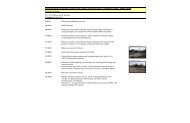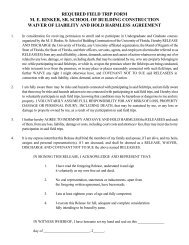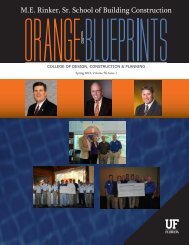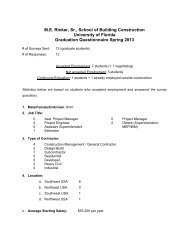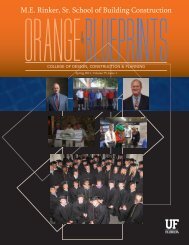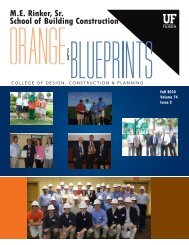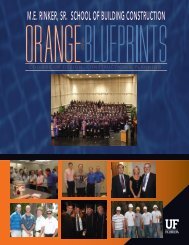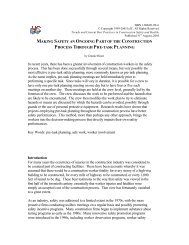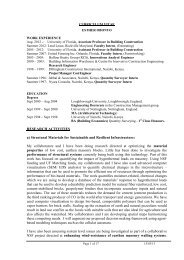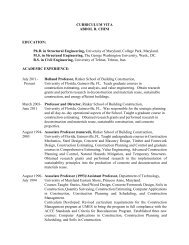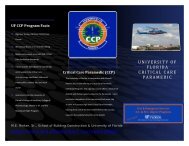Full Proposal in pdf - M E Rinker Sr School of Building Construction ...
Full Proposal in pdf - M E Rinker Sr School of Building Construction ...
Full Proposal in pdf - M E Rinker Sr School of Building Construction ...
You also want an ePaper? Increase the reach of your titles
YUMPU automatically turns print PDFs into web optimized ePapers that Google loves.
4) Comb<strong>in</strong>e the true costs, guidel<strong>in</strong>es, and the function analysis to def<strong>in</strong>e andgenerate a decision model.The methodology for the model will follow the follow<strong>in</strong>g five-step procedure(W<strong>in</strong>ston, 1993):a) Formulate the ProblemDef<strong>in</strong><strong>in</strong>g the problem <strong>in</strong>cludes specify<strong>in</strong>g the objectives and the parts <strong>of</strong> thesystem that must be studied before the problem can be solved. In this researchthe objective would either be to m<strong>in</strong>imize the true costs <strong>of</strong> an IAQ controloption or maximiz<strong>in</strong>g the cost-effectiveness <strong>of</strong> IAQ control options.b) Observe the SystemIn this phase the research will be oriented towards the collection <strong>of</strong> data thatwould affect the problem determ<strong>in</strong>ed <strong>in</strong> the previous section. The data to becollected <strong>in</strong>cludes: how much an <strong>in</strong>crease <strong>in</strong> productivity save the owner <strong>in</strong>costs; how much an <strong>in</strong>crease <strong>in</strong> the supplied air amount would <strong>in</strong>creaseproductivity; how much hard costs are associated with a unit <strong>in</strong>crease <strong>in</strong> theamount <strong>of</strong> air or the treatment <strong>of</strong> the air; how much energy cost occurs by the an<strong>in</strong>crease <strong>in</strong> the unit <strong>of</strong> outdoor air supply or recirculation air.c) Formulate a Mathematical Model <strong>of</strong> the ProblemIn this phase a mathematical model <strong>of</strong> the problem will be developed. Thismodel will <strong>in</strong>clude:- Decision Variables- Objective Function- Constra<strong>in</strong>tsSome <strong>of</strong> potential decision variables could be as follows:X1 = Amount <strong>of</strong> outdoor air suppliedX2 = Amount <strong>of</strong> air cleanedThe objective function could be configured as follows:M<strong>in</strong> z = C1X1+C2X2+…..CnXn (M<strong>in</strong>imize true costs)Max z = ∆ (cost) / ∆ (exposure) (Cost effectiveness)The potential constra<strong>in</strong>ts are not limited to:ASHRAE Constra<strong>in</strong>t (M<strong>in</strong>imum outdoor air)Productivity Constra<strong>in</strong>t (Maximum productivity)Ventilation Constra<strong>in</strong>t (Maximum energy for condition<strong>in</strong>g OA)Equipment Constra<strong>in</strong>t (Maximum amount <strong>of</strong> air can be cleaned)This phase will also <strong>in</strong>clude the sensitivity analysis <strong>in</strong> order to determ<strong>in</strong>e therange <strong>of</strong> optimality for the model. This will <strong>in</strong>clude the determ<strong>in</strong><strong>in</strong>g the values forthe shadow prices and the reduced costs to present the range <strong>of</strong> optimality. Figure3 represents a basic example for how the model would be structured.



